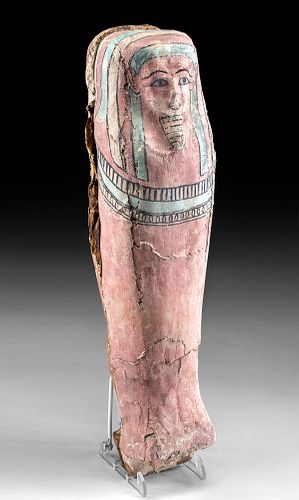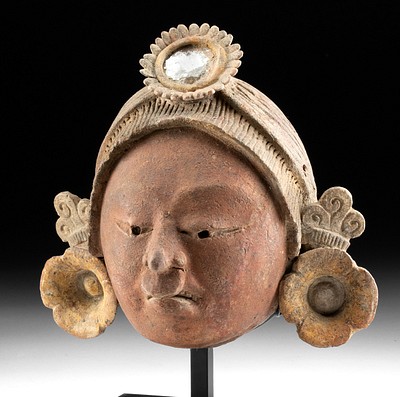Egyptian 26th Dynasty Painted Gesso / Wood Coffin Model
Lot 6a
About Seller
Artemis Fine Arts
686 S Taylor Ave, Ste 106
Louisville, CO 80027
United States
Selling antiquities, ancient and ethnographic art online since 1993, Artemis Gallery specializes in Classical Antiquities (Egyptian, Greek, Roman, Near Eastern), Asian, Pre-Columbian, African / Tribal / Oceanographic art. Our extensive inventory includes pottery, stone, metal, wood, glass and textil...Read more
Categories
Estimate:
$5,000 - $7,500
Absentee vs Live bid
Two ways to bid:
- Leave a max absentee bid and the platform will bid on your behalf up to your maximum bid during the live auction.
- Bid live during the auction and your bids will be submitted real-time to the auctioneer.
Bid Increments
| Price | Bid Increment |
|---|---|
| $0 | $25 |
| $300 | $50 |
| $1,000 | $100 |
| $2,000 | $250 |
| $5,000 | $500 |
| $10,000 | $1,000 |
| $20,000 | $2,500 |
| $50,000 | $5,000 |
| $100,000 | $10,000 |
| $200,000 | $20,000 |
About Auction
By Artemis Fine Arts
Jul 14, 2022
Set Reminder
2022-07-14 10:00:00
2022-07-14 10:00:00
America/New_York
Bidsquare
Bidsquare : Exceptional Antiquities Ethnographica Fine Art
https://www.bidsquare.com/auctions/artemis-gallery/exceptional-antiquities-ethnographica-fine-art-9692
Museum-worthy examples of classical antiquities (Egyptian, Greek, Roman, Near Eastern), Viking, Far East / Asian, Pre-Columbian, African / Tribal, Oceanic, Native American, Spanish Colonial, Fossils, Ancient Jewelry, Fine / Visual Arts, so much more! Artemis Fine Arts info@artemisgallery.com
Museum-worthy examples of classical antiquities (Egyptian, Greek, Roman, Near Eastern), Viking, Far East / Asian, Pre-Columbian, African / Tribal, Oceanic, Native American, Spanish Colonial, Fossils, Ancient Jewelry, Fine / Visual Arts, so much more! Artemis Fine Arts info@artemisgallery.com
- Lot Description
Egypt, Late Dynastic Period, 26th Dynasty, ca. 664 to 525 BCE. A wonderful example of a petite coffin model, made from two pieces of wood, adorned with gesso over linens, and then decorated with pigment in hues of pink, turquoise, black, and creamy white. The figural coffin exhibits a mummiform presentation with an ornamental band across the chest as well as a polychrome tripartite wig atop the head. The serene visage peers outwards with almond-shaped eyes bearing elongated canthi and has a flush nose, full lips outlined in black, cupped ears emanating from the temples, and a polychrome false beard; a column of hieroglyphs is displayed down the verso. Attached to the base is a third piece of wood that suggests this coffin model was meant to be displayed in a standing pose. The detailing and lack of an insertion cavity atop the head suggests this coffin model was not intended to resemble the more-common Ptah-Sokar-Osiris coffins. Size: 4.6" L x 4" W x 16.75" H (11.7 cm x 10.2 cm x 42.5 cm)
The verso of the coffin is painted with a column of hieroglyphs, though few are still legible. Their mirror image positions indicate that this was meant to be read in a right-to-left manner, and clearly we can see three "E"s at the top as well as the symbol for stairs a few lines down. Many of the other hieroglyphs seem to have been deliberately destroyed - the animal glyphs, in particular - a sad but unfortunately prevalent practice for objects placed in burial chambers. Based on a similar example in the British Museum, these hieroglyphs represented some kind of spells for protection in the afterlife. On the other side is a better preserved painting showing a mummiform body; the paint has faded to pale pink, blue, and cream, with black details including a goatee and crown. The facial details are well-painted and wonderfully Egyptian, with huge eyes and dark, large eyebrows. The interior of the coffin is empty; the hollowed-out chamber is only in the upper body, with the legs not cut out. This chamber would once have contained a model of a human figure, perhaps made of wax or mud. One suggestion for their purpose is that they were meant as replacements where a real body had been lost, perhaps in a fire or flood.
Provenance: private Lexington, Kentucky, USA collection; ex-Artemis Gallery, Louisville, Colorado, USA; ex-private Hagar collection, Wildwood, Missouri, USA; ex-private North Carolina, USA collection, acquired in the 1980s
All items legal to buy/sell under U.S. Statute covering cultural patrimony Code 2600, CHAPTER 14, and are guaranteed to be as described or your money back.
A Certificate of Authenticity will accompany all winning bids.
PLEASE NOTE: Due to recent increases of shipments being seized by Australian & German customs (even for items with pre-UNESCO provenance), we will no longer ship most antiquities and ancient Chinese art to Australia & Germany. For categories of items that are acceptable to ship to Australia or Germany, please contact us directly or work with your local customs brokerage firm.
Display stands not described as included/custom in the item description are for photography purposes only and will not be included with the item upon shipping.
#173451Repair to bottom portion with chipping to gesso as well as wood and adhesive residue along break lines. Possible touch-up painting to black details in scattered areas, else remaining pigment is original. Age wear, especially to the underside, with some losses to the wood along the connecting edges. Losses to the gesso and cracks to the paint/plaster are also present. Much artwork remains.Condition
- Shipping Info
-
All shipping is handled in-house for your convenience. Your invoice from Artemis Gallery will include shipping calculation instructions. If in doubt, please inquire BEFORE bidding for estimated shipping costs for individual items.
-
- Buyer's Premium



 EUR
EUR CAD
CAD AUD
AUD GBP
GBP MXN
MXN HKD
HKD CNY
CNY MYR
MYR SEK
SEK SGD
SGD CHF
CHF THB
THB

















